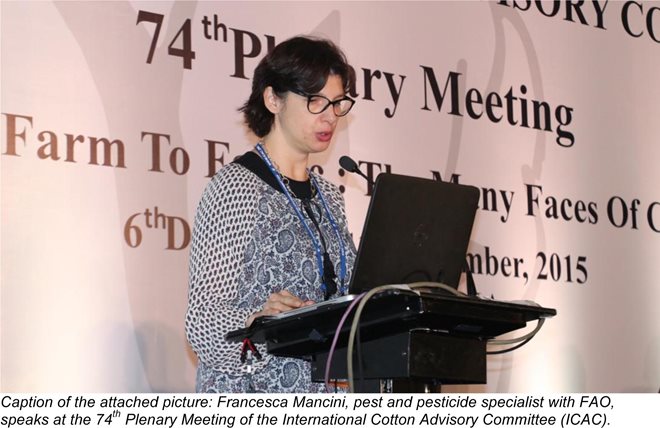Mumbai, India, December 16, 2015 – It sounds almost too good to be true: the complete eradication of insecticides in cotton cultivation. Could such a thing ever happen?
That was the question addressed by a panel of researchers and scientists during the Sixth Open Session of the 74th Plenary Meeting of the International Cotton Advisory Committee (ICAC), a technical seminar entitled Elimination of Insecticides from Cotton Production: Is This Possible?
While the bollworm has historically been cotton’s biggest archenemy, there are multiple secondary pests that continue to drive insecticide use, including the whitefly in Pakistan and India. This year, as much as two-third of the cotton crop in India’s state of Punjab suffered damage from a whitefly outbreak.
With so much at stake, the use – and sometimes overuse – of insecticides is understandable, as farmers tend to resort to pesticides as the first line of defense. Globally, more than $15 billion was spent on various insecticides in 2013.
In her presentation, Francesca Mancini, a pest and pesticide specialist with the United Nations Food and Agriculture Organization (FAO) presented statistics on insecticide use on cotton globally and in certain countries. Cotton’s share of total insecticide use in agriculture had dropped over the last 25 years. However, new increases in use have been registered in some countries due to outbreaks of secondary pests. Continuous efforts are required to educate farmers on ecological pest management. In the short term, the elimination of Highly Hazardous Pesticides (HHPs) from cotton production would contribute significantly to reducing risks to the environment and human health” she said.
Many insect problems, the panelists agreed, are induced by the improper use of agrochemicals and poor understanding of pest physiology. Farmers who apply the wrong chemicals at the wrong time exacerbate the problem. Great strides could be made toward reducing the amount of insecticides used, and increasing their efficacy, through education of growers. One such approach, they said, is Integrated Pest Management (IPM), which emphasizes the growth of a healthy crop with the least possible disruption to agro-ecosystems and encourages natural pest control mechanisms.

Source
ICAC, press release, 2015-12-16.
Supplier
Food and Agriculture Organization of the United Nations (FAO)
International Cotton Advisory Committee
Share
Renewable Carbon News – Daily Newsletter
Subscribe to our daily email newsletter – the world's leading newsletter on renewable materials and chemicals









